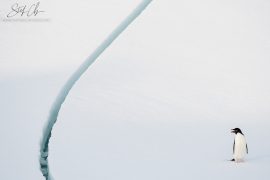
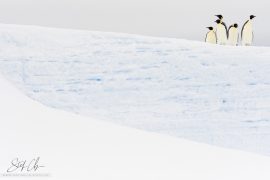
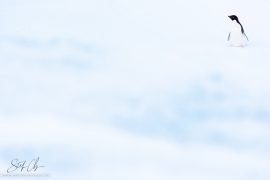
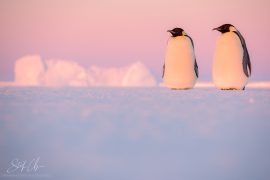
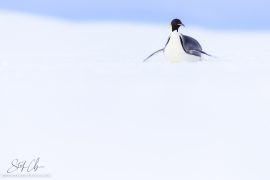
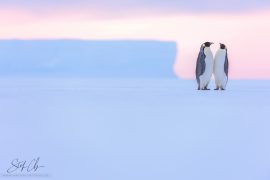
“Back in Antarctica: A Year With Birds” by Stefan Christmann (Website | Instagram | Facebook, see also his previous [NR] guest post, please click on images for larger view):
A Year With Birds
The monotonous sound of the Basler BT-67 plane hums in my ears when I wake up and open my eyes, just to get blinded by the incredible amount of light in the passenger cabin. I pull down my sunglasses and give my eyes a few seconds to adjust. It’s an overcast day, but the midnight Sun is still high enough in the sky to shine as bright as on a cloudless sunny day in central Europe. Europe – forests, mountains, street cafes, people – I won’t see all of that for 11 months. Instead I am back in a place, that my mind probably never quite left. I am back in Antarctica (see https://nikonrumors.com/2013/01/26/guest-post-my-year-in-antarctica.aspx/ for a report from the first trip). This time however, I will not be working as a scientist, who photographs this place in his free time. This time I am here as part of a BBC film-team and it will be my job to be out in the cold whenever the weather allows – and to take my camera with me wherever we go. It’s a dream come true and weirdly feels a bit like coming home.
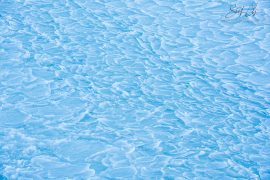
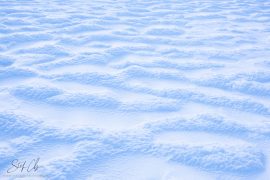
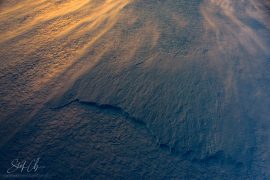
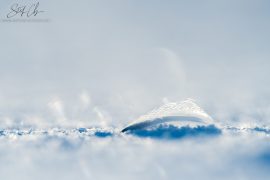
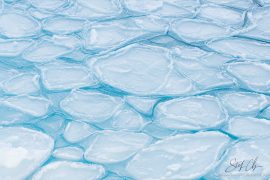
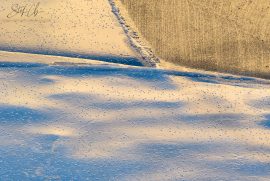
As we are flying across Atka Bay I can see some massive tabular icebergs in the distance. Through a hole in the cloud cover the sun shines onto the open ocean around them and reflections on the water surface glitter like a million diamonds spread out on a dark blue velvet cloth. In a few minutes we will reach our final destination. The German Antarctic Research Station Neumayer III. From above the station looks quite tiny and small, but I know that once we touch the ground, I will be amazed again by how much it looks like an alien spaceship, that has landed right in the middle of the white Antarctic desert. Neumayer is built on 200m thick shelf ice, which means, that it is technically a ship afloat on the Southern Ocean, being pushed North by the glacier at a rate of roughly 150m per year. It is located about 8km away from the edge of the shelf ice, where one of the biggest emperor penguin colonies of the continent is located. The birds are the reason we are here.
Our task is to get footage for a nature documentary about the emperor penguins of Atka Bay and accompany these majestic birds for an entire life-cycle throughout the year. From their arrival in the bay, through mating and egg laying until the hatching of the chicks and their final fledge, we will try to film every aspect of their more than amazing life in one of the most hostile environments on Earth. In order to succeed in our endeavor we are equipped with the latest tech in high-end camera gear (way beyond 4K) and will utilize the incredible logistic infrastructure of Neumayer station.
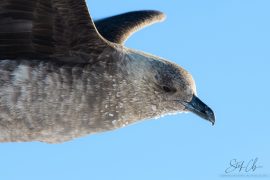
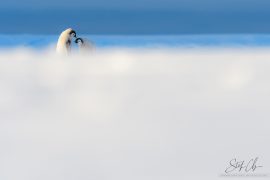
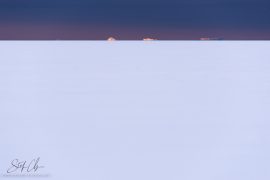
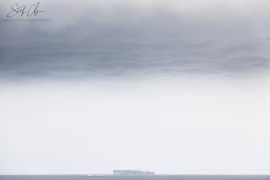
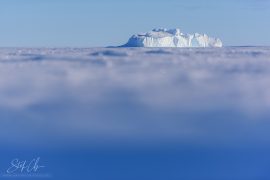
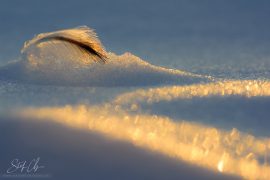
My role in the team is threefold. Since I am the only one with extensive polar experience, I will take care of safety and assess the terrain and the weather in which we are filming. This is probably one of the trickiest tasks, since you can never be 100% safe in a place like Antarctica. However, if you know which cracks you can „trust“ and which ones you can’t, one can play it rather safe and not take any unnecessary risks. The same is true for weather. Everybody wants to see footage of the bad stormy weather, which the penguins have to endure, but for human beings this can be life-threatening. You can easily become disoriented and then freeze to death or at least get severe frostbite in your extremities. Finding a „bad weather window“, which is still manageable by humans is therefore essential for a successful sequence. Aside from this I am working as a camera assistant and expedition photographer for the program. Photographic equipment can be rather heavy, but film equipment is even worse. One single battery for our main camera for example weighs more than all of my DSLR batteries combined – it becomes quite clear that this cannot be handled by one person alone, especially not in the field. Consequently I will help the cameraman to transport and set up his equipment on location and sometimes even help him operate it (for example when getting jib-shots or tracking shots with the DJI ronin). Once he is enabled to film, I grab my camera in order to get promotional stills for the program. Unfortunately I will not be able to show most of them until after the final selection of stills has been made for the program in early 2018. Some of them however are peppered along these lines. At this point, they are mostly non-penguin related, but I promise this will change in the next post, if you want an update :).
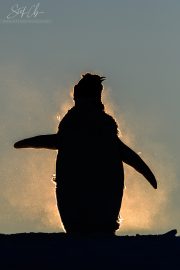
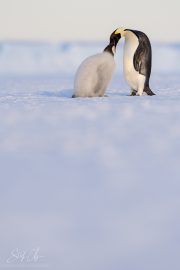
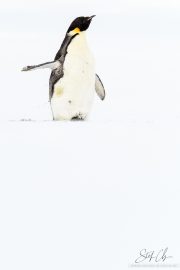
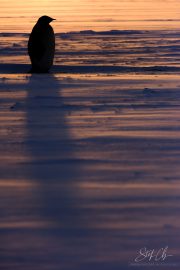
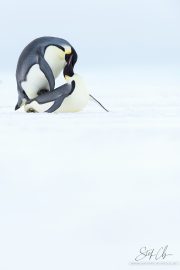
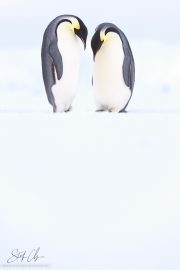
It’s been five months now since we landed at Neumayer and time has passed incredibly quickly, which is probably due to all the amazing things we have seen in that timeframe. We have spent well over 100 days outside, some days lasting as long as 15 hours and we only stay inside, if conditions are really, really bad (like the 60 knot storm that we are experiencing as I write these lines). During the Antarctic summer, which lasts roughly from November until February, we saw the sea ice of Atka Bay break open, leaving the bay absolutely ice-free. Orcas and Minke whales roamed the waters during that time and a large amount of Antarctic birds like storm petrels, snow petrels, giant petrels as well as kelp gulls were present as well. Some emperor penguins had even made their way up onto the shelf ice, which is not their usual habitat. It made for some unique footage. A few weeks later, temperatures dropped considerably and the ocean began to freeze again, which resulted in the most wonderful ice structures one can imagine. Wherever you looked, there was art floating on the water, which slowly solidified and eventually got covered by snow. Then it got quiet in Atka Bay as most animals had disappeared to spend the Antarctic winter in warmer regions of the Antarctic circle and the emperor penguins had not yet returned.
During this time we truly experienced the isolation and the barrenness of Antarctica hearing no sounds, but only the squeaking of freshly formed ice sheets rubbing against each other. Days were getting shorter and shorter with the Sun rising less high in the Sky with every passing day and our bodies slowly got used to temperatures below -25°C. Then in April, we finally heard a sound again, that we had missed for nearly two months. The trumpet like call of the emperor penguins unison mixed into what many people describe as a cacophony. For me however, the trumpet like sounds made by the emperors are like music and I would rather describe them as a euphony of unique melodies. Bird by bird they started coming back in long lines and we were more than excited to see them pouring in the perfect spot for us: very close to where we had set up a living and kit storage container on top of the shelf ice.
Currently the emperor penguins have gathered in their „old“ spot – the southernmost point of Atka-Bay, which they have been using as a breeding ground for the past 30 years. They are forming a colony of around 8000 individuals or roughly 4000 breeding pairs. Seeing and hearing (and smelling) such a large number of birds in one place is truly breathtaking and an incredible privilege, I feel very strongly about. Not many people are given a chance like this in their life, which is the reason why I am doing everything I can to make every minute of our stay count.
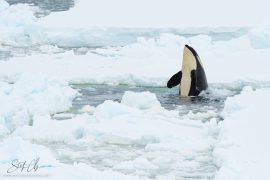
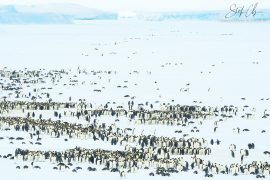
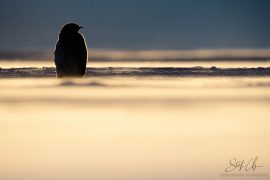
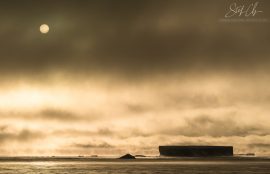
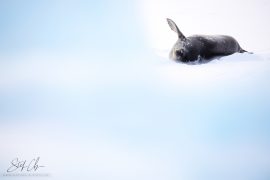
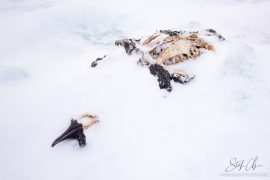
Prior to embarking on this journey I carefully planned which gear I would bring and how I could achieve a good level of redundancy without having to rob a bank. Unfortunately there are no stores in Antarctica where you could buy new gear in case something broke. As a freelancer I have to pay for every piece of kit myself, so getting a spare for everything just wasn’t a feasible solution. Consequently, there were some things, that needed to be taken into consideration. For example, if one of my cameras broke, would the other one be capable of producing the same image, but maybe with a bit of extra work needed from my side? Or, do I have overlap in the focal lengths of my lenses? Could I use two lenses for the same job (maybe one with an extender)? Of course, whenever something breaks, it means a setback in terms of productivity and maybe in quality, but it is important, that you do not have to stop your work altogether. For that reason I have a combination of fixed focus and zoom lenses as well as a 1.4x teleconverter, which can take me up to 560mm on my D810 body or even 840mm equivalent on the D500 (I will present a list of most of my kit at the end of this article). Buying new kit however is only half the story. If you are going to use it on an important assignment, you should know exactly how it performs, in which situations it works best and in which situations you need to work around its flaws. Consequently, in May 2016 I took all of my new equipment (aside from the D500 and 105 f/1.4E lens, which were not available yet) to Iceland for an intense two week field test/workshop, just to get familiar with everything prior to my departure. In fact, some of the images I published in my previous Iceland guest post (https://nikonrumors.com/2016/07/02/traveling-to-iceland.aspx/) were taken with gear that I specifically bought for Antarctica.

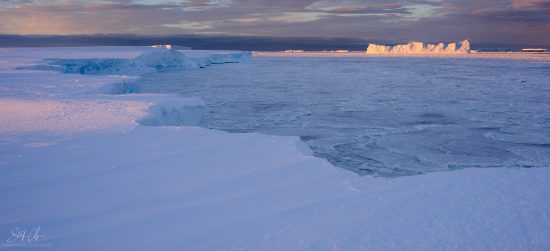
Finally, being on assignment for 11 months (or even in the field for that matter) it means that you have to think about backing up your shoots. At home I store my image database on a 12 TB NAS, as well as backups of that NAS on external harddrives, which I keep in different locations. Last but not least, I use an online backup service in case something went terribly wrong (as probably quite a few people have experienced with ransomware in the past year). Due to our limited bandwidth an online backup service cannot be used in Antarctica and buying yet another NAS alongside with more external harddrives would have been quite costly. Instead I decided to buy one 3TB Western Digital Elements drive and a total of eight 2TB drives, which are relatively cheap, easy to transport and also (in my experience) quite reliable. I am rigorous when it comes to deleting images, so I barely ever have days on which I keep more than 10GB of files (that is excluding 4K video shot on the D500 and timelapses). If you assume 270 days of shooting (the rest is bad weather), that is roughly 3TB of storage needed. So, I can store my entire image database for this shoot on the 3TB drive and have mirrored copies of my files on the 2TB drives, which means, that at all times, I have three copies of my entire image database. I would have to be incredibly unlucky for all drives to fail at the same time (if one drive failed, I’d still have unused spare drives). However, one luxury I don’t have in Antarctica is being able to physically keep the drives in separate locations, since we only have one station. Fingers crossed that this will not be an issue though ;).
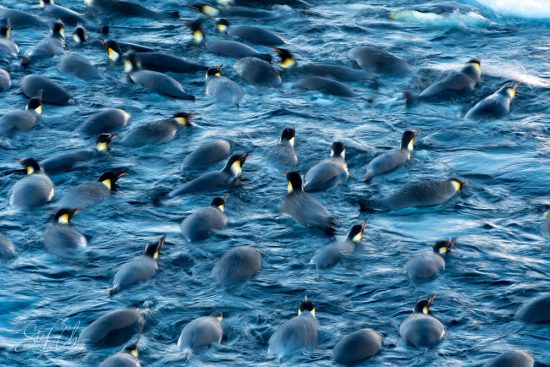
When it comes to photographing in a place like Antarctica, oftentimes you are confronted with scenes, that have a very large dynamic range. Emperor penguins are stunningly beautiful birds, but they are a nightmare to photograph on a sunny day. You will either blow out the white feathers on their belly or underexpose their eyes, which are almost invisible due to the black feathers on their head. The same is true for ice features on overcast days. If you expose to the right, it is hard to differentiate subtle structures in the ice, since these only really show when they cast shadows (and hence the Sun in shining). In 2012 I often struggled with these situations and was never quite sure how to regain image information in post production. One thing which has surely improved my photography immensely and has helped me to get better exposures is shooting flat picture profiles. Honestly, I had never paid much attention to picture profiles, since I knew that they could be changed in Lightroom anyway. What I never thought about though was, that picture profiles DO affect the image preview you will see on the back of your camera screen (as this is a small in-camera JPEG) and consequently alter the histogram, which is shown to you. A flat picture profile will show you a more even distribution of highlights, mid-tones and shadows and therefore will be a better guidance for your exposure. Also mind your white balance settings as this will also affect the preview JPEG and therefore the histogram. If your white balance is way off, a single color channel could be clipping even though your overall image is underexposed in the remaining channels (especially true if your scene contains a lot of white). After all you always want the best basis for post production when you are shooting RAW (best signal to noise ratio).
As I stated above, I feel beyond privileged for being able to experience Antarctica in this intense way, but being completely honest, there are days (especially the ones when we can’t film) when I feel it all comes with a price. I know many people would give their left hand to be in my shoes, but bear in mind, that we are giving one year of our lives for this project. I have not seen my beloved wife for five months and I will not see her for another six months to come. The same is true for my parents and my friends and I can only keep in touch with them via Whatsapp/Email and via phone (with a 1s delay). Also, staying at a research base has its quirks. You are „locked in“ with 11 other people and these are the only people you will get to see over the year, the only ones you will sit at the dinner table with and the only ones you will have for everyday conversation. Last but not least, polar night has just begun and the Sun will not rise for 60 days now. While we can cope with the lack of daylight by using very sensitive low light cameras for filming, my body is getting quite tired and getting up in the morning is as hard as it has ever been. My friends at home keep sending me photos of Europe with everybody running around in shorts and T-shirts, enjoying the Sun and the colors of summer. I can’t help, but feel jealous every now and then.
One thing I know however is, that once this storm has passed and we are heading back to the emperor penguin colony, my mind will be reenergized and time will start to fly again. Finally, we all can’t wait to see the finished film at the end of 2018. Keep your eyes open for a BBC program on emperor penguins – it will be amazing! 🙂
If you want to follow our progress and our experiences during our assignment, follow my blog (www.nature-in-focus.de) or my social media like Instagram (@christmannphoto) and Facebook.
Here are the most important pieces of equipment I brought along for this assignment. Of course, not all of them are in my backpack at the same time ;).
- Nikon D810 + MB-D12 battery grip
- Nikon D500 + MB-D17 battery grip
- Sony RX100 IV Compact Camera
- AF-S Nikkor 14-24mm 1:2.8G ED
- AF-S Nikkor 70-200mm 1:2.8G ED VRII
- AF-S Nikkor 24-120mm 1:4.0G ED VR
- AF-S Nikkor 105mm f/1.4E
- AF-Micro Nikkor 105mm f/2.8D
- PC-E Nikkor 45mm f/2.8E
- AF-S Nikkor 400mm 1:2.8E FL ED VR
- Meyer-Optik-Goerlitz Trioplan 100mm f/2.8
- Sigma APO Macro DG HSM 180mm f/2.8D
- Sigma EX DG Fisheye 15mm f/2.8
- Nikon TCE-14II 1.4x Teleconverter
- Gitzo GT5562LTS / Novoflex ClassicBall 5II + Novoflex Q-Base
- MacbookPro 13“ Retina (early 2015), i5 2.9GHz, 16GB Ram
- EIZO CG2730 27“ Wide Gamut Monitor
- SanDisk SD-Cards at 32 and 64GB (I prefer smaller memory cards)
- EN-EL15 batteries + chargers
- EN-EL18 batteries + MH-26 double charger
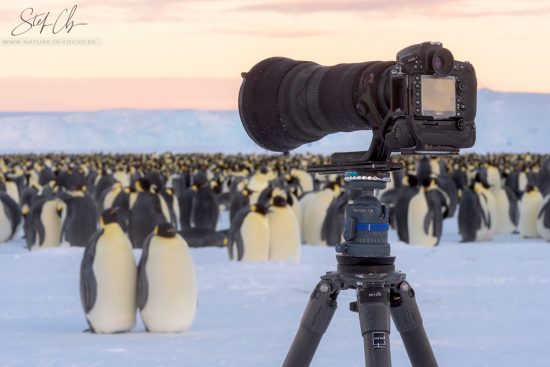
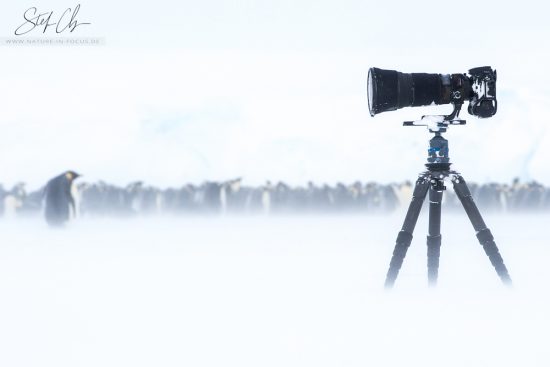
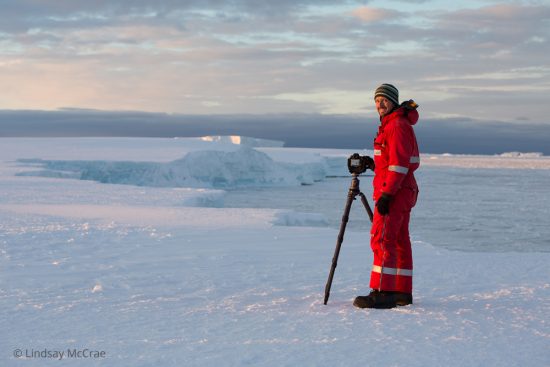
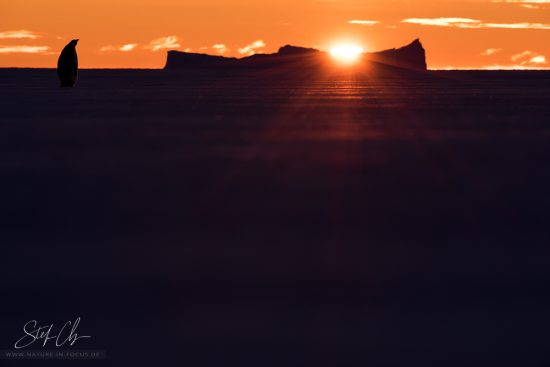
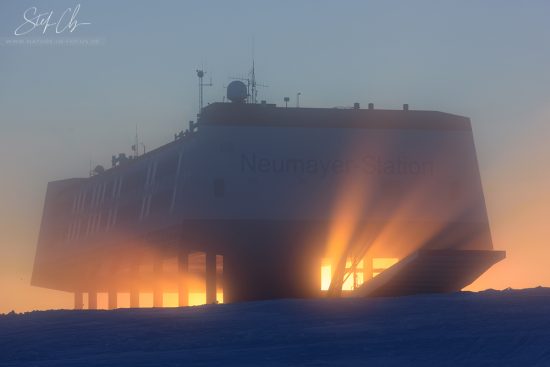

If you have an interesting idea for a guest post, you can contact me here.






